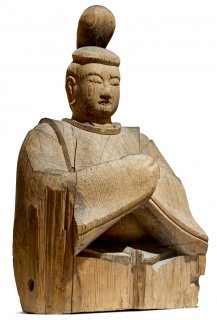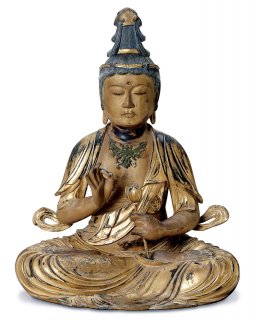
Japanese
Shinto Male Deity
Japanese cypress; single woodblock construction Height: 21 ½ inches Museum purchase with funds provided by the Honorable Jefferson Patterson 1979.145
Now You See It, Now You Don’t
Count yourself lucky to see this sculpture. Originally, this figure would probably have been hidden from view in a shrine, not meant to be seen by the public. Why? What exactly is it? Find out by exploring the ancient Japanese tradition of Shinto.
A Day in the Life
Shinto
This sculpture is a product of Shinto, the indigenous spiritual tradition of Japan. What is Shinto? What does this figure represent? What role does Shinto play in contemporary Japanese society? Find out in the following video from the Asian Art Museum.
© Copyright Asian Art Museum Chong-Moon Lee Center for Asian Art and Culture, 2003
Transcript:
Shinto is Japan's earliest religion. Its followers respect and hold rituals for kami—formless, invisible spirits that animate all things and all life. Natural phenomena, humans, and inanimate objects can be vessels for kami. Shinto began its development more than 2,000 years ago. It consisted of rituals for the well-being of the community.
Shinto shrines are everywhere in Japan. They range from small household altars to large complexes. Some are found at rural sites, while others are part of the urban landscape. A shrine building is thought to be a temporary residence for the kami, represented by a sacred object, hidden from view inside the inner sanctuary. Visitors to a Shinto shrine enter through a torii [gate]. The torii separates everyday space from sacred space. Visitors purify themselves by rinsing their hands and mouths with water from a basin. In front of the shrine, they call for the kami's attention, and might petition for a healthy child or success in college entrance exams. Good luck charms are for sale, and visitors can leave written petitions on special plaques or strips of white paper that will later be used in a ritual by the priests.
Kami are occasionally represented in human form, such as these two artworks in the [Asian Art] Museum. However, many traditional arts, like sword-making, are connected with Shinto practice.
Most Japanese mark important personal moments at shrines—such as coming-of-age ceremonies and weddings. Though its roots are ancient, Shinto practice is part of contemporary life. At the many annual Shinto festivals, kami are asked to bless the community and its economic livelihood. The kami are jostled in their portable shrines as a way to entertain them during their visit. Purification rites are prominent in Shinto rituals. Water and even fire are used. People visit shrines in large numbers at New Year's, to seek good fortune in the coming year. These Shinto practices have developed and adapted to changing lifestyles in Japan for hundreds of years and surely will continue to evolve in the future.
Tools and Techniques
Behind the Scenes
Look Closer
A New Look
Look closer at the fine wood grain in this sculpture. Was this the original finish? What can it tell us about the artist’s attitudes towards the material? Join the following discussion between Elyse Fenstermacher, Digital Content Coordinator at The DAI from 2012–2013, and former Asian art consultant Lisa Morrisette to learn more.
Transcript:
Lisa Morrisette: What is particularly gorgeous about this work is that you have this very contained form—you really have a sense of the log, the tree that this was part of. The work is closed and contained within that form.
Elyse Fenstermacher: Yes, and the arms are folded in and the very quiet, sort of subsumed expression on the figure's face all speak to that. But in terms of talking about the material it comes from, I’m absolutely fascinated by the development of lines and striations on the surface of this figure—and you can definitely tell that there are remnants of pigment, especially of black pigment on the top of the figure’s head—but as that’s worn away, some 500 years after this image was created, it’s taken on a completely new look on the surface.
LM: Which is really interesting, the idea of the patina of an object; how an object changes. But in this particular case it’s really wonderful how it blends with the original concept, the idea that the tree from which this was carved was a sacred object. The tree itself was a sacred material, and Japanese sculptors really preferred wood. That was the main medium that they worked in. Lacquer was also another medium. But wood, there was a reverence for the material and you can get a sense of that as you look closely at this; you can really see how the artist is working with the grain. And so, as the paint has worn away, it has revealed the quality of the wood beneath that—the sacred object.
EF: It’s taken on an entirely new life as it’s aged, which might not have been an intended effect by the sculptor, but certainly the sculptor’s care and intention as far as respecting the original material is concerned, it’s all part of the process.
LM: You’re absolutely right, that wouldn’t have been the original intention, but they would have approached the carving of this with that kind of attention and reverence, and that really shows through.
Just for Kids
Imagine!
Shinto is an early religion in Japan. It started to develop over 2,000 years ago. This Shinto figure would have been placed in a shrine in a home or religious building, and not on view like it is now.
Imagine the Shinto deity could talk. What might he be saying about being on view to the public? Do you think he would like to be in the museum and Dayton?
Signs & Symbols
What is that hairdo?
The tall shape sitting on the top of the figure’s head is not actually hair, but a traditional hat called a kanmuri. Made of lacquered cloth, a kanmuri was part of the formal imperial court attire worn by emperors and aristocrats. Today it is primarily worn by Shinto priests on special occasions. Another part of the formal court attire was a shaku, a flat, scepter-like piece of wood. This figure held a shaku at one time; it fit into the groove you can see on the top of his hands.
Depicting the Shinto kami (spirits) in the guise of the ruling elite was a natural way to show the high status of the kami, and also indicates the close connection between Shinto and the imperial court.
Dig Deeper
Arts Intersected
The Sculpture Speaks
Did You Know?
Expert Opinion
Look Around
Shinto vs. Buddhist Sculpture
There are two main spiritual traditions in Japan. One is Buddhism, which came to Japan from China and Korea in the 6th century. The other is Shinto, an indigenous tradition that worships kami, spirits that are manifest throughout the natural world. Before Buddhism, Shinto did not represent kami in human form, but when Buddhism arrived with its rich tradition of figurative art this began to change, although human figures of kami tend to be an exception.
An example of Buddhist sculpture is located nearby, the Kannon Bosatsu. The two sculptures are a similar size, from a similar time period, and entered The DAI collection in the same year, 1979. But there are also differences. For example, the Shinto figure was carved from a single block of wood. The Kannon figure, in contrast, was made with multiple blocks of wood that were carved separately and joined together. This makes the sculpture lighter, since it is hollow inside. It also helps prevent cracking, since with a solid block of wood the outside dries faster than the inside, creating cracks on the surface, such as those on the Shinto figure.
Look closer at the materials, textures, and overall finishes of both sculptures and consider how these contribute to the impression you get from each.

Japanese, Kannon Bosatsu (Avalokiteshvara), 15th–16th century, wood with lacquer, gilding, pigments, copper, crystal, and beads, 17 ½ x 13 in. Museum purchase with funds provided by Virginia Rike Haswell, 1979.49.
About the Artist
Talk Back
The Art of Decomposing
A masterpiece is often thought of as a work that has withstood “the test of time.” This sculpture is out of its original context, has lost its legs and coat of paint, and the wood is even cracked and eaten by insects in places. However, it is still being appreciated by visitors to The DAI. Does an object’s status as a masterpiece depend on it being available for people to see it? How can it remain important even after it completely decomposes?

